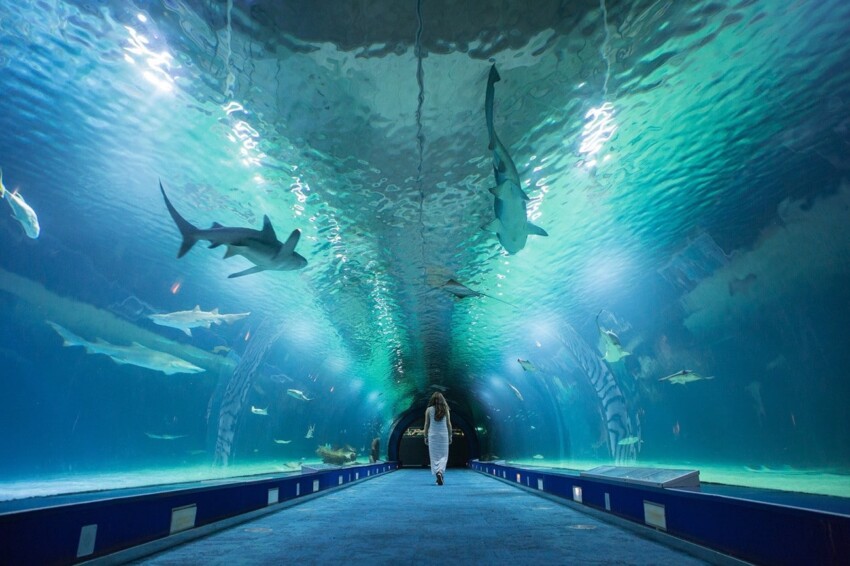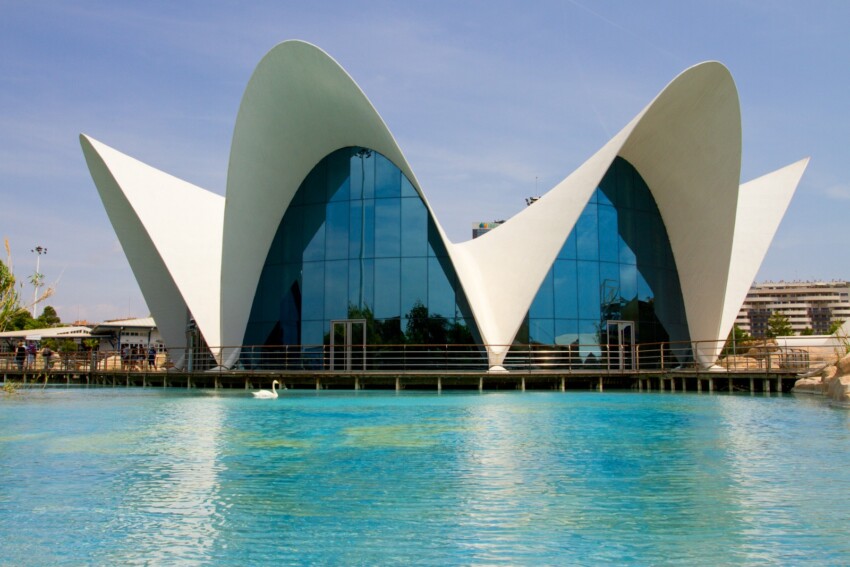
The Valencia Oceanogràfic Park is considered the largest marine park in Europe and is definitely one of the must-see stops during a visit to the city. The main marine ecosystems can be explored here and there are around 500 species with a total of 45,000 specimens. This veritable aquatic museum is part of the complex known as Ciutat de les Arts i les Ciències (The City of Arts and Sciences), which was designed by architects Santiago Calatrava and Félix Candela.
The avant-garde architecture, the presence of numerous species and the scientific, educational but also playful slant of the Oceanogràfic make this site the perfect destination for adults and children alike. In addition, visitors are informed about the problems of the marine world and the activities to protect its flora and fauna.

A visit to the Oceanogràfic Valencia includes several areas that allow visitors to discover the most important ecosystems of the seas and oceans of planet Earth. In addition to the buildings that narrate the marine flora and fauna, there are other sections such as the information point, the medical service, several shops and numerous restaurants, including an underwater restaurant. There are many special species present such as walruses, belugas, Humboltd penguins, seals and flamingos. Among the most impressive areas are the 70-metre long underwater tunnel (which is considered the largest in Europe) and the 10.5-metre deep dolphinarium.
The section dedicated to the Mediterranean extends over seven rooms and allows visitors to get to know the richness and biological variety that characterises the Mediterranean Sea; in particular, as the depth increases, it is possible to observe the change in the communities of organisms present. Thus between fish and invertebrates, around 7,400 specimens can be observed here.
Not far from the Mediterranean area is an aviary, i.e. a sphere approximately 26 metres high inside which two wetlands have been reconstructed. Specifically, here are the Mediterranean wetlands and the American ‘mangrove’ where mangroves grow. There are many animals to admire, including flamingos.
This area of the Oceanogràfic houses two large aquariums with the different ecosystems of the temperate and tropical seas. The visit leads from the waters of the Atlantic Ocean to those of the Caribbean through a tunnel more than 70 metres long, the longest in Europe.
The largest aquarium at the Valencia Oceanogràfic is definitely the one located in the oceans section. Here you can discover the ecosystem found in the waters of the Atlantic and Pacific
In the 7 million cubic metres of water you can also admire species such as the bull shark, the grey shark and the sunfish.
Two different sections are dedicated to the Arctic and Antarctic worlds. In particular, the building housing the Antarctic world is home to penguins, with areas for hatching and breeding young and an underwater area where you can watch the birds dive.
The Arctic, on the other hand, is reproduced inside an igloo-shaped dome that contains rocky cliffs and numerous animal species such as walruses and belugas.
Islands & Red Sea are two buildings located close together. The first is open-air and reproduces the typical island environments of the South American coast. In this area, one can see large colonies of sea lions typical of Patagonia.
In the Red Sea building, on the other hand, there is an auditorium that can seat more than 400 people and whose floor consists of a scenographic aquarium representing the seabed of the Red Sea.
The Dolphinarium at Valencia’s Oceanogràfic is considered one of the largest in the world with its 26 million cubic metres of water and a depth of 10.5 metres. There are five pools and a large staircase that can accommodate up to 1,500 spectators. Dolphin performances are organised daily.
The Oceanogràfic is one of the most visited attractions in Valencia and to visit it you need to buy an entrance ticket or take part in a guided tour. There are different types of tickets: choose the one that suits you best! We recommend that you visit it at off-peak times, i.e. early in the morning or late in the afternoon.
Due to the large number of tourists at the Oceanogràfic, we recommend that you buy a ticket with priority entry. This will save you a lot of time in line at the entrance, especially during the high season.
If you want to combine your visit to the Oceanogràfic with other attractions in the City of Arts and Sciences, choose a combination ticket: you can save considerably on the entrance fees for the individual attractions.
Visiting hours at the Valencia Oceanogràfic vary according to the time of year.
The ticket offices close one hour before the aquarium closes.
The Valencia Oceanogràfic can be easily reached by public transport or by bicycle.
Those travelling by metro can use the Alameda stop, which is on line 3 of the Valencia Metro, while those travelling by bus can take the EMT lines number 95 and number 15, which stop right at the entrance to the site.
Those arriving by car can park their vehicle at the car park of the Oceanogràfic, which offers discounted rates for visitors.
Valencia offers plenty of bicycle rental points and the city has several bicycle lanes that allow you to get around comfortably by bike.
The Oceanogràfic is the City of Arts and Sciences’ most southeastern facility, in other words the most remote and least easily accessible. Likewise, it is also the least built-up area, so it will be impossible to find accommodation right across the street. If walking 500-600 metres does not frighten you, along Carrer d’Antonio Ferrandis you can stay at a hotel of the Holiday Inn chain, while beyond Pont l’Assut de l’Or, along Carrer de Menorca, there are two 4-star hotels: the Primus Valencia and the AC Hotel Valencia by Marriott.
If you prefer to sleep in a flat, you’ll have to make do with staying about one kilometre from the entrance to the Oceanogràfic: opposite the main facilities of the City of Arts and Sciences, close to the Montolivet Bridge, there are some excellent flats that will allow you to visit the Oceanogràfic and the City without any major hindrances.
The Oceanogràfic Valencia is located approximately 3.5 km from the city centre. The site is located within 'The City of Arts and Sciences' Complex, along with other important museums.
City Card allow you to save on public transport and / or on the entrances to the main tourist attractions.
